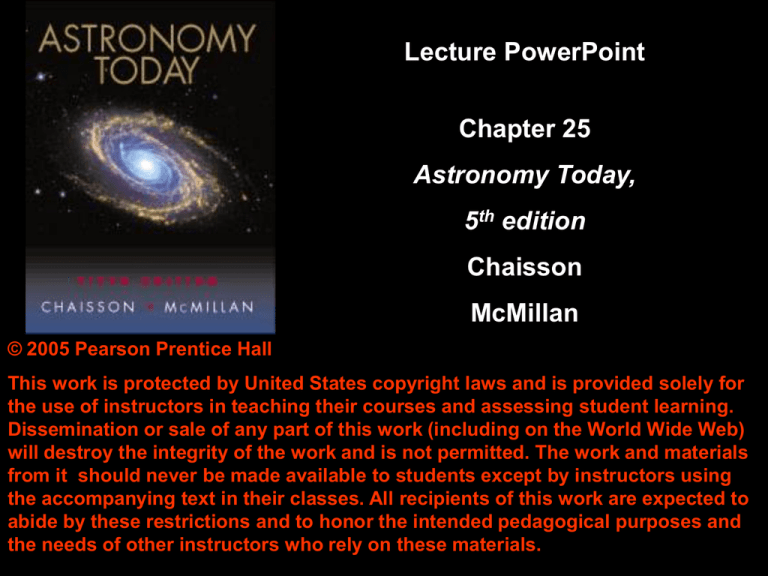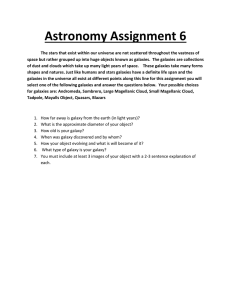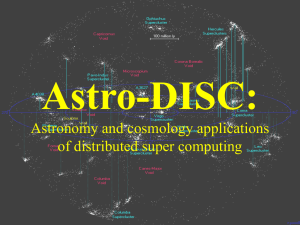
Lecture PowerPoint
Chapter 25
Astronomy Today,
5th edition
Chaisson
McMillan
© 2005 Pearson Prentice Hall
This work is protected by United States copyright laws and is provided solely for
the use of instructors in teaching their courses and assessing student learning.
Dissemination or sale of any part of this work (including on the World Wide Web)
will destroy the integrity of the work and is not permitted. The work and materials
from it should never be made available to students except by instructors using
the accompanying text in their classes. All recipients of this work are expected to
abide by these restrictions and to honor the intended pedagogical purposes and
the needs of other instructors who rely on these materials.
Chapter 25
Galaxies and Dark Matter
Units of Chapter 25
Dark Matter in the Universe
Galaxy Collisions
Galaxy Formation and Evolution
Black Holes and Active Galaxies
The Universe on Large Scales
The Sloan Digital Sky Survey
25.1 Dark Matter in the Universe
Other galaxies have rotation curves similar to
ours, allowing measurement of their mass:
25.1 Dark Matter in the Universe
Another way to
measure the average
mass of galaxies in a
cluster is to calculate
how much mass is
required to keep the
cluster gravitationally
bound.
25.1 Dark Matter in the Universe
Galaxy mass measurements show that galaxies
need between 3 and 10 times more mass than can
be observed to explain their rotation curves.
The discrepancy is even larger in galaxy clusters,
which need 10 to 100 times more mass. The total
needed is more than the sum of the dark matter
associated with each galaxy.
25.1 Dark Matter in the Universe
This image may show a galaxy interacting with an
unseen neighbor – a “dark galaxy.”
25.1 Dark Matter in the Universe
There is evidence for
intracluster superhot
gas (about 10 million K)
throughout clusters,
densest in the center:
25.1 Dark Matter in the Universe
This head–tail radio galaxy’s lobes are
being swept back, probably because of
collisions with intracluster gas:
25.1 Dark Matter in the Universe
It is believed this gas is primordial – dating
from the very early days of the universe.
There is not nearly enough of it to be the
needed dark matter in galaxy clusters.
25.2 Galaxy Collisions
The separation between galaxies is usually not
large compared to the size of the galaxies
themselves, and galactic collisions are frequent.
The “cartwheel”
galaxy on the left
appears to be the
result of a head-on
collision with another
galaxy, perhaps one of
those on the right.
25.2 Galaxy Collisions
This galaxy collision has led to bursts of star
formation in both galaxies; ultimately they will
probably merge.
25.2 Galaxy Collisions
The Antennae galaxies collided fairly recently,
sparking stellar formation. The plot on the right is
the result of a computer simulation of this kind of
collision.
25.3 Galaxy Formation and Evolution
Galaxies are believed to have formed from mergers of
smaller galaxies and star clusters. Image (c) shows large
star clusters found some 5000 Mpc away. They may be
precursors to a galaxy.
25.3 Galaxy Formation and Evolution
This Hubble Deep Field view shows some
extremely distant galaxies. The
most distant appear irregular,
supporting the theory of galaxy
formation by merger.
25.3 Galaxy Formation and Evolution
These starburst galaxies show
evidence of massive, recent
activity. Image (a) is clearly
galaxies in collision. Image (b)
appears to have a supermassive
black hole at its center. Image (c)
is also the result of a collision.
25.3 Galaxy Formation and Evolution
This appears to be an instance of galactic
cannibalism – the large galaxy has three cores.
25.3 Galaxy Formation and Evolution
This simulation shows how interaction with a
smaller galaxy could turn a larger one into a
spiral.
25.4 Black Holes and Active Galaxies
These visible and X-ray images
show two supermassive black
holes orbiting each other at a
distance of about 1 kpc.
They are expected to merge in
about 400 million years.
25.4 Black Holes and Active Galaxies
The quasars we see are very distant, meaning
they existed a long time ago. Therefore, they
may represent an early stage in galaxy
development.
The quasars in this
image are shown
with their host
galaxies; many
appear to be
involved in
collisions.
25.4 Black Holes and Active Galaxies
The end of the quasar epoch seems to have
been about 10 billion years ago; all the
quasars we have seen are older than that.
The black holes powering the quasars do not
go away; it is believed that many, if not most,
galaxies have a supermassive black hole at
their centers.
25.4 Black Holes and Active Galaxies
This galaxy is viewed
in the radio spectrum,
mostly from 21-cm
radiation. Doppler
shifts of emissions
from the core show
enormous speeds very
close to a massive
object – a black hole.
25.4 Black Holes and Active Galaxies
This figure shows how galaxies may have evolved, from
early irregulars through active galaxies, to the normal
ellipticals and spirals we see today.
25.5 The Universe on Large Scales
Galaxy clusters join in
larger groupings,
called superclusters.
This is a 3-D map of the
Local Supercluster, of
which our Local Group
is a part. It contains
tens of thousands of
galaxies.
25.5 The Universe on Large Scales
This slice of a larger galactic survey shows that,
on the scale of 100–200 Mpc, there is structure in
the universe – walls and voids.
25.5 The Universe on Large Scales
This survey, extending
out even farther, shows
structure on the scale
of 100–200 Mpc, but no
sign of structure on a
larger scale than that.
The decreasing density
of galaxies at the
farthest distance is due
to the difficulty of
observing them.
25.5 The Universe on Large Scales
Quasars are all very distant, and the light
coming to us from them has probably gone
through many interesting regions. We can
learn about the intervening space by careful
study of quasar spectra.
25.5 The Universe on Large Scales
This “Lyman-alpha forest” is the result of
quasar light passing through hundreds of gas
clouds, each with a different redshift, on its
way to us.
25.5 The Universe on Large Scales
This appeared at first to be a double quasar, but on
closer inspection the two quasars turned out to be
not just similar, but identical – down to their
luminosity
variations.
This is not
two quasars
at all – it is
two images of
the same
quasar.
25.5 The Universe on Large Scales
This could happen via gravitational
lensing. From this we can learn about
the quasar itself, as there is usually
a time difference between the two
paths. We can also learn about
the lensing galaxy by
analyzing the bending
of the light.
25.5 The Universe on Large Scales
Here, the intervening galaxy has made four
images of the distant quasar.
25.5 The Universe on Large Scales
These are two spectacular images of gravitational lensing.
On the left is distant galaxies being imaged by a whole
cluster.
On the right is a cluster with images of what is probably a
single galaxy.
25.5 The Universe on Large Scales
On the left is a visible image of a cluster of
galaxies.
On the right, to the same scale, is the dark matter
distribution inferred from galaxy motion.
Summary of Chapter 25
• Galaxy masses can be determined by rotation
curves and galaxy clusters
• All measures show that a large amount of dark
matter must exist
• Large galaxies probably formed from the
merger of smaller ones
• Collisions are also important
• Merger of spiral galaxies probably results in an
elliptical
Summary of Chapter 25, cont.
• Quasars, active galaxies, and normal galaxies
may represent an evolutionary sequence
• Galaxy clusters are gravitationally bound into
superclusters
• The universe has structure up to 100–200 Mpc;
beyond that, there is no sign of it
• Quasars can be used as probes of intervening
space, especially if there is galactic lensing







